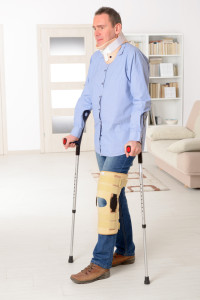I have represented so many injured workers who have suffered an injury to the knee that was so severe it either immediately or eventually led to the claimant having to undergo a total knee replacement surgery. Knee replacement surgery is a scary thing to come face to face with, so I wanted to share this information by Dr. Shiel with any injured worker who might be looking at having a knee replacement now or in the future.
What is a total knee replacement?
By: WILLIAM C. SHIEL JR., MD, FACP, FACR, CHIEF EDITOR
“A total knee replacement is a surgical procedure whereby the diseased knee joint is replaced with artificial material. The knee is a hinge joint which provides motion at the point where the thigh meets the lower leg. The thighbone (or femur) abuts the large bone of the lower leg (tibia) at the knee joint. During a total knee replacement, the end of the femur bone is removed and replaced with a metal shell. The end of the lower leg bone (tibia) is also removed and replaced with a channeled plastic piece with a metal stem. Depending on the condition of the kneecap portion of the knee joint, a plastic “button” may also be added under the kneecap surface. The artificial components of a total knee replacement are referred to as the prosthesis.”
These are the potential risks of undergoing surgery:
- Blood Clots
- Pulmonary embolism
- Urinary tract infection, nausea, and vomiting (usually related to pain medication)
- Chronic knee pain and stiffness
- Bleeding into the knee joint
- Nerve damage
- Blood vessel injury
- Infection
- Potential heart, lung, kidney, and liver damage (usually related to anesthesia)
After Knee Replacement Surgery
“A total knee replacement generally requires between one and a half to three hours of operative time. After surgery, patients are taken to a recovery room, where vital organs are frequently monitored. When stabilized, patients are returned to their hospital room.”
“Passage of urine can be difficult in the immediate postoperative period, and this condition can be aggravated by pain medications. A catheter inserted into the urethra (a Foley catheter) allows free passage of urine until the patient becomes more mobile.”
“Physical therapy is an extremely important part of rehabilitation and requires full participation by the patient for optimal outcome. Patients can begin physical therapy 48 hours after surgery. Some degree of pain, discomfort, and stiffness can be expected during the early days of physical therapy. Knee immobilizers are used in order to stabilize the knee while undergoing physical therapy, walking, and sleeping. They may be removed under the guidance of the therapist for various portions of physical therapy.”
“A unique device that can help speed recovery is the continuous passive motion (CPM) machine. The CPM machine is first attached to the operated leg. The machine then constantly moves the knee through various degrees of range of motion for hours while the patient relaxes.”
“Patients will start walking using a walker and crutches. Eventually, patients will learn to walk up and down stairs and grades. A number of home exercises are given to strengthen thigh and calf muscles.”
Dr. Shiel’s article gives us the general understanding of what happens and what you can expect with a knee replacement surgery. However, you should ALWAYS address any questions or concerns you have with your doctor. This information is for informative purposes only and is NEVER to be taken as medical advice.
If you are facing the possibility of a knee replacement surgery as the result of a work injury or if you would like some more information on Virginia workers’ compensation system, order my book “The Ultimate Guide to Workers’ Compensation in Virginia,” or call our office today (804) 755-7755.
About the Author: Michele Lewane
The Injured Workers Law Firm is a Richmond, Virginia based firm solely focused on serving clients with workers' compensation claims in Virginia. If you have questions about your benefits or if you would like more information on the Virginia workers’ compensation system, order our book, “The Ultimate Guide to Workers’ Compensation in Virginia” , or call our office today (804) 755-7755.


